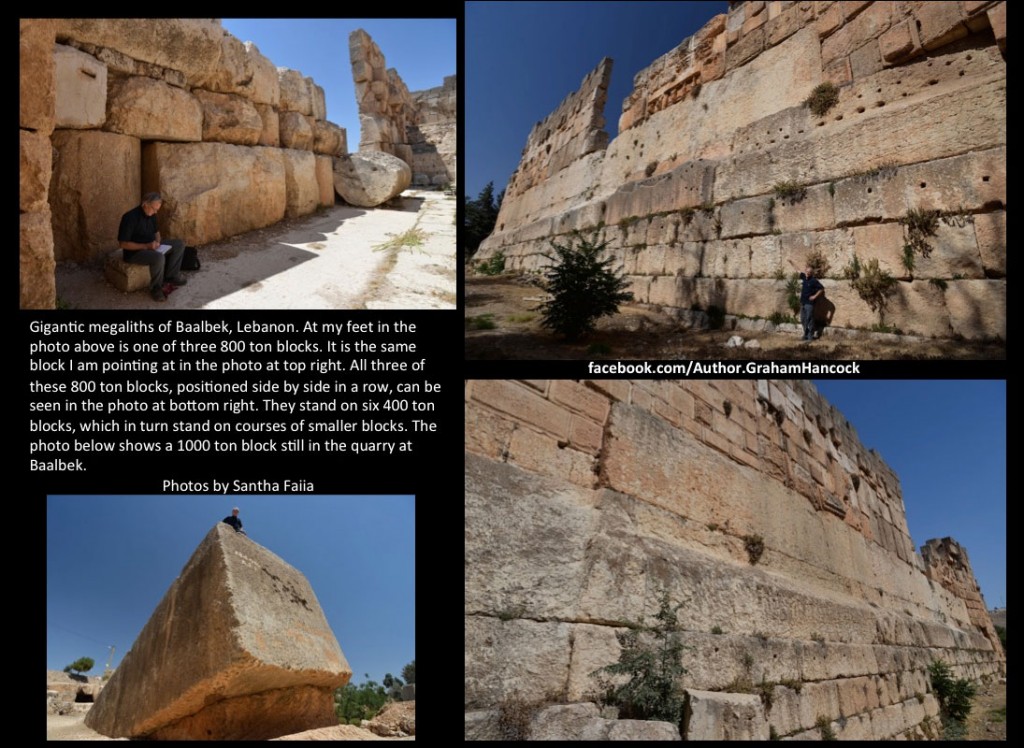I made a research trip to Lebanon in July 2014 and reported here on the recent discovery of a third gigantic megalith in the quarries at Baalbek (in the Beqaa Valley), about a kilometre from the famous Roman temple of Jupiter. Here’s a link to my 11 July report: http://on.fb.me/11EqNqz. Now we have more information from the German Archaeological Institute that has been studying and measuring the newly discovered megalith which is described as 19.60 metres long, 6 metres wide and at least 5.5 metres high. Its weight is estimated at about 1,650 tons which makes it significantly more massive and significantly heavier than the two previously known blocks in situ in the quarry. The German Archaeological Institute’s findings are set out on the following pages:
(1) http://bit.ly/1uWvgvs;
(2) http://bit.ly/1uRZsIi;
(3) http://bit.ly/1FGdQLQ;
(4) http://bit.ly/1FFWxso.
The newly discovered block is shown in the first collage of photographs. I am standing on it in the photo at top left and it’s front edge is shown in the photo at mid-left. For the record I do NOT agree with the mainstream archaeological view that any of the three megalithic blocks in the quarry, or the enigmatic megalithic foundations of the Temple of the Jupiter, are the work of the Romans. I believe these huge megaliths long predate the construction of the Temple of Jupiter and are likely to be 12,000 or more years old — contemporaneous with the megalithic site of Gobekli Tepe in Turkey. I suggest we are looking at the handiwork of the survivors of a lost civilisation, that the Romans built their Temple of Jupiter on a pre-existing, 12,000-years-old megalithic foundation, and that they were unaware of the giant hewn megaliths in the ancient quarry as these were covered by sediment in Roman times (as, indeed, the newly discovered block still was until very recently). I set out my reasoning for this point of view in a further report on 14 July and both my 11 July and my 14 July reports are pasted in again below for reference.My report of 11 July 2014. (https://www.facebook.com/Author.GrahamHancock/photos/pb.31260747353.-2207520000.1417276842./10152591539632354/?type=3&theater)
The first collage of photos is intended to help those who are interested to understand the situation of the main megalithic blocks still in the quarry at Baalbek in Lebanon.
I’ve stood in on three of the five photos for scale (top left, bottom left and bottom right). These photos feature the so-called "Stone of the Pregnant Woman" which is estimated to weigh a little more than 1,000 tons. Immediately left of it in the photo at bottom left a second huge (mainly buried) megalith has recently been uncovered. I’m standing on top of this recently uncovered megalith in the photo at top left. The photo at left centre shows the front end of this newly uncovered megalith.The photo at top right is of a third megalith in a different part of the quarry that is now used as a rubbish dump (hence the black tyres chucked on top of it). Although this megalith looks smaller than the "Stone of the Pregnant Woman" large parts of it are still buried and calculations suggest it weighs in excess of 1,200 tons.Please note the megaliths featured in this collage are ALL still in the quarry. They are not part of any structure. In my second report (14 July) I focus on the megaliths, some weighing in excess of 800 tons, that were moved a distance of about a mile from the quarry to create a giant platform on top of which the Romans later built a Temple of Jupiter. Mainstream archaeology says all this quarrying and moving of huge megaliths was done by the Romans. Unsurprisingly I believe mainstream archaeology to be wrong! I’ll explain further and show photos of the huge blocks on top of which the Temple of Jupiter is built in my next post.My report of 14 July 2014. (https://www.facebook.com/Author.GrahamHancock/photos/pb.31260747353.-2207520000.1417276842./10152597881907354/?type=3&theater)
See second collage of photos.I’m not persuaded by the archaeological case that the megalithic foundations of the Temple of Jupiter in Baalbek, Lebanon, were the work of the Romans. There’s no doubt that the Romans could move very large blocks of stone, and there’s no doubt that they were responsible for the classical majesty of the temple itself, but I’m presently working on the assumption that they built it on top of a megalithic platform that had already been in place for thousands of years. The western side of that original (and I believe remotely ancient) megalithic platform is shown in the collage of photographs with this post. On top of six megaliths, in the range of 400 tons each, are prominently positioned three gigantic megaliths weighing approximately 800 tons each. I am aware that megaliths even larger than this (e.g. the so-called Thunder Stone of St Petersburg) have been moved and positioned on flat ground in historical times) but the moving and positioning of three 800 ton megaliths to a height of 18 or 20 feet above the ground as is the case at Baalbek is a problem of a completely different order. I suggest this requires careful consideration rather than simply saying "the Romans did it" as archaeology is at present inclined to do.I have many reasons for this view, to do with the possibility of a lost civilisation that I will be exploring in depth in "Magicians of the Gods", the sequel to "Fingerprints of the Gods" (to be published October 2015). However to consider just a single point here we need only turn to the quarry at Baalbek where a number of even larger megaliths (but clearly of the same type as the 800-ton blocks under the Temple of Jupiter), were left in situ by whoever conceived it possible to build with megaliths on this scale. If it was the Romans who quarried and moved everything than we have to ask ourselves why three huge blocks in the range of 1,000 to 1,650 tons were left in the quarry at all.
The conventional answer is that the Romans, having quarried these exceptionally large blocks, found that they could not move them and simply abandoned them. But that explanation makes very little sense. If the argument that the Romans were responsible for the megalithic platform is correct then we know that they went on to build an extensive temple complex dedicated to Jupiter using smaller blocks of stone. Surely their first source for the multiple smaller blocks they needed would have been the huge megaliths that, according to the argument of mainstream archaeology, they had discovered they could not move from the quarry? The Romans were practical people who would not allow work that they had already so painstakingly done to go to waste. Rather than opening up fresh quarry faces, wouldn’t they have used those massive, already almost completely quarried 1,000-ton-plus blocks and simply sliced them up into smaller more moveable megaliths for the construction of the rest of the temple?
It’s really puzzling that they didn’t do so and therefore the fact that these gigantic, almost finished blocks remain in the quarry and were never sliced up into smaller blocks and used in the general construction of the Temple of Jupiter, suggests to me very strongly that the Romans did not even know they were there. Most probably they had been buried under many metres of sediment for many thousands of years when the Romans appeared on the scene. They made use of the megaliths that were already in place on the already remotely ancient sacred site that would become the Temple of Jupiter — a handy, massive and convenient platform upon which they could build their temple — but they knew nothing of the fully cut and shaped but unused megaliths lying deeply buried in the quarry. This is a working hypothesis at the moment, nothing more, but I will explore its implications fully in “Magicians of the Gods”.







